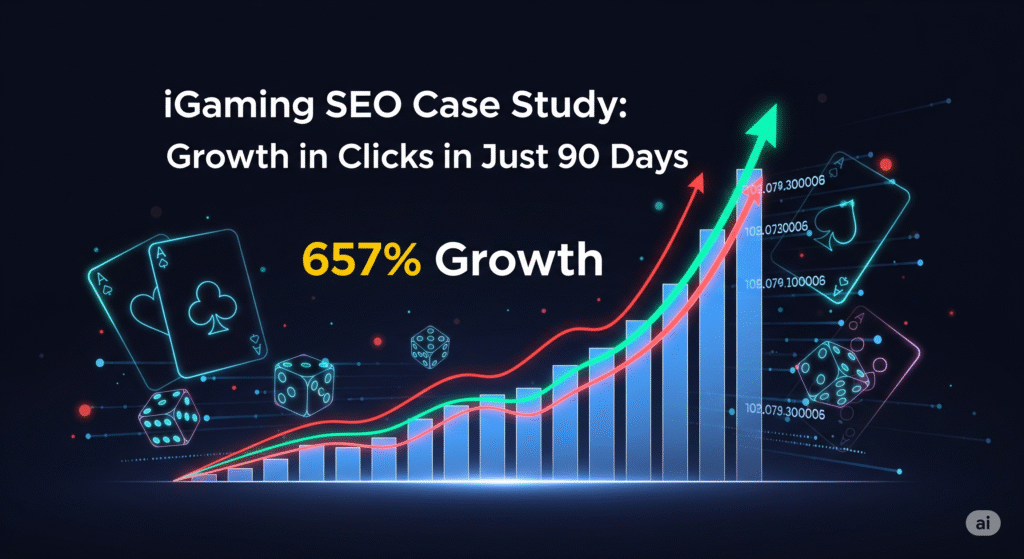The iGaming industry is one of the most competitive digital landscapes. With high competition, strict compliance regulations, and ever-changing search engine algorithms, achieving significant organic growth in this niche is no easy feat.
But in just three months, one iGaming site dramatically increased its organic performance:
- Clicks: From 5,500 to 41,900 (+657%)
- Impressions: From 79,200 to 506,000 (+539%)
- Average Position: Improved from 15.9 to 10.9
- CTR: Rose from 7% to 8.3%
In this comprehensive case study, we’ll break down how these results were achieved, what strategies fueled the growth, and how you can apply similar tactics to your own iGaming (or high-competition) project.
1. The Context: A Fresh iGaming Domain
The project started with a brand-new domain entering a saturated market. Despite not having a powerful link graph or historical authority, the site took a strategic approach to technical architecture and user intent alignment.
One notable point: the site benefited from two major Google Broad Core Algorithm Updates (BCAUs) — in March and June. However, it wasn’t just a matter of timing — the domain was strategically positioned to benefit from these updates.
2. Technical Strategy: Subdomains, Exact Match Domains & Query Matching
A. Exact Match Domains (EMDs) & Subdomains
In highly commercial SERPs, EMDs can still play a big role — especially when aligned with brand + bonus or brand + login queries.
For example:
betkinglogin.comslotsbonushub.site
These domains mimic highly searched terms and often receive immediate engagement because they mirror real-world intent.
Subdomains also play a key role:
bonuses.domain.comreviews.domain.com
Using subdomains allows for topic segmentation, clearer topical authority, and siloed indexing — all of which help with scalability and SEO clarity.
3. Strategic SEO Levers Used
A. Ranking Scale & Ranking States
Contrary to popular belief, Google doesn’t rank individual pages in isolation. Instead, domains carry a ranking scale — a kind of authority weight — and Google uses this scale to test your content across queries and categories.
Once a domain proves itself within a “ranking state,” it’s more likely to be included in broader query sets. This case validated a long-standing SEO hypothesis: domains can earn ranking potential over time, especially after core updates.
B. Avoiding Query Conflict
A common SEO mistake is targeting the same keyword with multiple pages, which confuses Google and dilutes authority. In this case, the team used:
- One page per core query
- Unique topical clusters with internal linking
- Canonical tags to consolidate signals
The result? Clean indexation and faster ranking movement.
C. Brand-Relevance Mapping
Many iGaming players search using brand-modified queries:
[brand] bonus[brand] login[brand] affiliate
The site replicated these queries with accurate content and brand-style UI to mimic familiarity and enhance CTR.
4. Link Profile & PageRank Consolidation
Unlike traditional SEO, this site didn’t rely heavily on backlinks. Instead, it focused on consolidating PageRank through smart internal linking and domain clustering.
Key tactics:
- Strategic use of
nofollowto prevent dilution - Deep internal linking from supporting pages to core pages
- Using subfolders (e.g.,
/bonuses/,/login-guides/) for logical crawl flow
Even with minimal external links, the site’s structure allowed authority to circulate effectively.
5. CTR Optimization: Copy, Design & Trust Signals
The site achieved an above-average CTR of 8.3% — a big leap from the initial 7%. This was done by:
- Writing titles with urgency & value (e.g., “[Brand] Bonus 2024 – No Deposit Codes Inside”)
- Meta descriptions with clear CTAs (e.g., “Claim your free spins instantly. No credit card needed.”)
- Schema markup for reviews, FAQs, and breadcrumbs
Additionally, the site used visual trust cues:
- Use of SSL, payment logos, and user ratings
- Brand-colored CTAs
- Minimal ad clutter and fast-loading UX
6. Algorithm Update Timing & Domain Classification
The site saw boosts during both March and June’s Broad Core Algorithm Updates. But why?
Google increasingly classifies domains by type — blog, affiliate, local, or forum — and serves results accordingly. In this case:
- Pages were presented as local-like listings (e.g., “Top Slots Sites in Ontario”) and gained traction in localized results.
- Structured data + location tags helped classify pages into the right “SERP state.”
7. Lessons Learned: What Actually Worked
- Ranking states are real: Building topical authority over time boosts performance — not just content.
- PageRank can be earned internally: You don’t need 1,000 backlinks if your internal flow is tight.
- SERP behavior matters: Mimicking familiar brand + intent queries increases both ranking and CTR.
- Structure over shortcuts: While some SEOs still use black-hat tactics (like cloaking or AMP mirrors), those methods carry huge risk. Sustainable success lies in understanding Google’s ecosystem — not cheating it.
8. What’s Next: Scaling Toward 1M Clicks/Month
With consistent indexing, SERP alignment, and structured scaling, the domain is projected to reach over 1 million clicks/month within the year.
Planned next steps include:
- Regionalized expansion: Using ccTLDs or subfolders for local SEO.
- Expired domain filtering system: Targeted acquisition based on region, authority, and risk.
- Topic depth: Building content silos across underutilized keywords and evergreen FAQs.
Final Thoughts
This case study shows that success in competitive niches like iGaming doesn’t require a massive budget or shady tactics. With the right architecture, query strategy, and content design, even new domains can thrive.
By treating your domain as a ranking state rather than just a collection of pages — and aligning every element with user intent — you can build a site that not only ranks but stays ranked.

